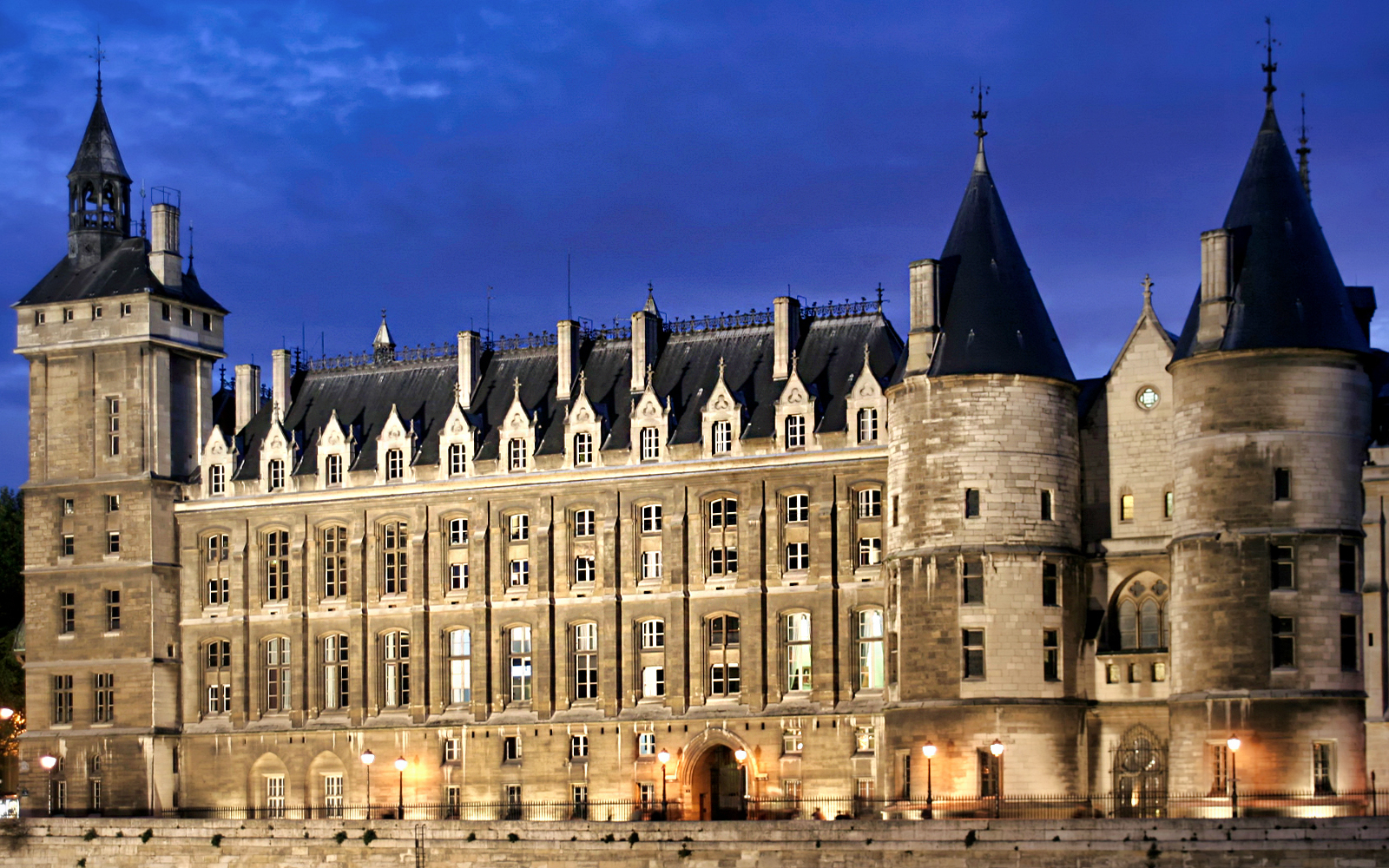A riverside fortress turned French Revolution prison, the Conciergerie is the most impressive 14th century Gothic marvel situated on the Île de la Cité, in the heart of the first arrondissement of Paris.
The four enormous minarets, pieces of the royal treasure, a wonderful primordial clock, gothic vaulted interiors, and many artefacts from the past make the Conciergerie one of the most visited Paris attractions. Now, the Conciergerie invites visitors to from all over the globe to explore the rich heritage of the French capital and boasts of its glorious past.

The Conciergerie - In a Nutshell
Handy information
| ⏰ Suggested Duration: | 1.5 hours |
| ☀️ Best Time to Visit: | 11 AM to 4 PM |
| 💜 Must See: | Expiatory Chapel |
| 🎟️ Sainte Chapelle and Conciergerie | €18.50 |
Must-see
The Expiatory Chapel
Hall of Names
The Hall of Men at Arms
Memory Objects
The Royal Kitchens
Things to know
Type: Palace, Courthouse, Prison
Architectural style: Gothic
Location: Ile de la Cite, Paris, France
Built in: 6th century
Opening Hours And Address
9.30 AM to 6 PM, on all days of the week
1st May – Closed
25th December- Closed
Address: 2 Boulevard du Palais, 75001 Paris, France
Get Directions
Why is the Conciergerie Worth Visiting?
- It serves as one of the few remaining examples of Gothic architectural marvels that has endured the test of time, and is now a treasury of ancient relics.
- It has witnessed most of Paris' history. Conciergerie is located where the Romans built their first fortification in Paris following their victorious conquest of the city.
- It was constructed on the ruins of an ancient fort and served as the French Kings' royal home for more than 1300 years.
- The edifice is currently a patchwork of many architectural styles that have been added to the core structure during the span of various dynasties.
- You can witness the transformation of what formerly served as a royal castle into the House of Justice and then a prison in Paris.
- The ambiance of the jail is enough to evoke feelings of eeriness, melancholy, and nostalgia all at once, making it a must-do activity while in Paris.
The Conciergerie Tickets
You can club your Conciergerie experience with Sainte Chapelle with these skip-the-line tickets!
History of the Conciergerie
The Conciergerie was originally built as a royal palace in the 14th century, during the reign of King Philip IV. It was later converted into a prison during the French Revolution in the late 18th century. During this time, the building was used to hold political prisoners, including Marie Antoinette, who was imprisoned in the Conciergerie before her execution in 1793.
After the Revolution, the building was used as a courthouse and a prison once again, until it was finally decommissioned in 1914. It was then transformed into a museum, allowing visitors to explore the building's rich history and architectural beauty.

Architecture of the Conciergerie
The Conciergerie is a striking example of Gothic architecture. Originally built as a royal palace in the 14th century, it later served as a prison during the French Revolution. The building features imposing towers, soaring arches, and stone carvings, showcasing the intricate details and grandeur of the Gothic style. Inside, visitors can explore the halls and cells that once held famous prisoners such as Marie Antoinette, and gain insight into the turbulent history of France. Today, the Conciergerie stands as a testament to the enduring beauty and historical significance of Gothic architecture.
The building's most striking feature is its massive clock tower, which rises high above the rest of the structure. The tower features intricate carvings and statues, including a statue of the Archangel Michael slaying a dragon, a symbol of good triumphing over evil.
The interior of the Conciergerie is just as impressive as its exterior. The main hall features soaring ceilings, intricate stone arches, and ornate carvings. You can also explore the prison cells, where famous prisoners were held before their execution during the Reign of Terror.
Highlights of the Conciergerie
1The Expiatory Chapel of Marie-Antoinette
The Marie-Antoinette memorial chapel was built in honour of the fallen Queen during the Restoration of 1815, a time in French history when the House of Bourbon reclaimed power, at the initiative of King Louis XVI. In addition to "The Queen's Testament" and three portraits of the Queen showing her imprisoned, it has a marble monument dedicated to the monarch. The chapel has just one stained glass window for light, and there are stone teardrop decorations on the walls of the faux-marble black colour.

2Women’s Courtyard
The Women's Courtyard, where Marie-Antoinette and other female prisoners were permitted to exercise, hasn't changed much since the Revolution. During that time, convicts could wash their clothes in the gardens, patios, stone tables, and fountains.

3 The Royal Kitchens
The Royal Kitchens were once built on two levels, with the staff's meals being cooked on the lower level while the cuisine for the royal family and guests was prepared on the higher level. Eight huge windows were originally present in the kitchen, but all but two were sealed up once it was converted into a prison. Eight hundred German and French knights and the royal guests were served a meal of three courses with ten dishes in each course that was prepared by the upstairs and downstairs kitchens and served in the Grand Hall.

4The Hall of Men at Arms
Philip IV constructed the Hall of the Men-at-Arms (Salle des Gens d'Armes) on the ground floor around the beginning of the 14th century. It is the largest non-religious Gothic Hall in Europe due to its enormous dimensions. It served as a dining room and social hub for the palace's armed guards and servants, who totaled between one and two thousand people.

5Hall of Names
The names of more than 4,000 people who were judged by the Revolutionary Tribunal and given death sentences are written on the walls of the Hall of Names. Although 20% of the convicts were members of the old nobility and clergy, the majority were from the middle or lower classes. Visitors can look up the biographies of fifty well-known detainees who were executed during the Terror via a touch screen.

Best Time to Visit the Conciergerie
The finest months to visit the Conciergerie in Paris are from April to June and again from October to early November. These times of the year continue to provide ideal climate conditions for travel and sightseeing. The temperature ranges would be mild, and there would be very few days with significant rainfall. You can also choose to visit Paris in the months of December, January, or February if you want to reduce your travel costs.
Additionally you can learn more about the Best Time to Visit Paris.
The Conciergerie Timings
- Every day from 9:30 AM to 6 PM
- 1st May – Closed
- 25th December - Closed
- The ticket office closes at 5:15 PM
Getting There
- Metro: Line 4 (Cité or Saint Michel station), lines 1-7-11-14 (Châtelet stop).
- RER: Line B or C, Saint-Michel station
- Bus: Lines 21-24-27-38-58-81-85-96 and Balabus
- Batobus: Notre Dame or Hotel de Ville stop
- Car: There is an underground parking in front of the Palais de Justice for visitors coming to the Conciergerie by car.
Insider Tips to Visiting The Conciergerie
- For convenience, visitors should carry essentials mostly, since they will need to go through a security check at the building's entry.
- Be sure to look at the film and the written warnings in the building's back room. These components might provide you a better glimpse into the location's significance and history.
- While at the Conciergerie, it is suggested you use the Histopad, a touch-screen tablet that uses augmented reality to enable you explore a reproduction of the Palace.
- Take some time to examine and marvel at the spectacular gothic structure from the outside before entering the Conciergerie. This is highly recommended to soak in the beauty of the marvellous architecture.
- The Clock Tower is unquestionably a masterpiece of architecture and is visible from the Boulevard du Palais. Use the Pont au Change to cross the Seine in order to take in a panoramic view of the Conciergerie.
- Travel light, wear airy clothes and walking shoes. Ditch your high heels to explore the place in comfort.
- Plan your trip and buy tickets well in advance to avoid last minute hassle and confusion at the entrance.
- The Conciergerie is not wheelchair accessible and there are multiple sets of steps throughout the facility. Those with limited mobility should plan accordingly.
Restaurants near the Conciergerie

This Michelin 3-star establishment is the pinnacle of fine dining in Paris and is led by the renowned French chef Guy Savoy. Enjoy the most intricate French treats along with the most cherished French wines.
Distance from the Conciergerie - 750 m

Only on the weekdays from noon to 2:15 p.m. and from 7:15 to 10:30 p.m. is Ze Kitchen Galerie open for lunch. Since Ze Kitchen Galerie's menu is influenced by the market, expect the selections to change from week to week and feature daily specials.
Distance from the Conciergerie - 900 m

The Korean food is the main draw of Comptoir Coréen - Soju Bar. A lot of guests come here to savour the delectable kimchi and expertly prepared bibimbap. This restaurant's chef makes excellent parfait.
Distance from the Conciergerie - 1 km

Come to Naked Burger if you want the chance to try vegetarian fare. This restaurant's chef makes the most delicious vegan burgers. Also, the majority of reviewers remark on how kind the staff is. The interior is pink, which lends the space a unique attractiveness.
Distance from the Conciergerie - 1.1 km
Things to do around the Conciergerie
Hotels around Conciergerie
Economy Stays
FAQs
The Conciergerie is a palace turned prison and is still regarded as one of Paris' most significant buildings because of its connection to the city's imperial past. This building is renowned for both its architectural brilliance and the fact that it served as the holding facility for convicts before they were executed by hanging.
The Conciergerie is one of Paris' finest examples of Gothic architecture despite its gloomy surroundings. Both history enthusiasts and casual visitors enjoy this baroque masterpiece. The seemingly empty walls are actually crammed full with knowledge. Additionally, it's a fantastic chance to see the Sainte-Chapel.
The Parisian Parliament was housed at the Conciergerie. In 1391, a portion of the structure was converted into a prison, housing both common criminals and political prisoners, including Ravaillac, King Henry IV's assassin
The two towers were constructed at the start of the 14th century by Philippe IV. Later in the 14th century, the lower levels of the towers were connected to the Conciergerie prison and used as dungeons until the French Revolution.
During the French Revolution, the Conciergerie served as the venue for the Revolutionary Tribunal's hearings, where almost 3,000 people were given the death penalty. One of the most well-known prisoners, Queen Marie-Antoinette, spent her dying moments in one of these chambers before being put to death. La Conciergerie is a historic building in Paris, France, that is located on the western side of the Île de la Cité. It was formerly a prison but is now largely used for courts.
It takes one to two hours to thoroughly visit the Conciergerie in Paris and see all the noteworthy sites and features, and observe the historic artefacts.
The finest months to visit the Conciergerie in Paris are from April to June and again from October to early November. December, January, or February are ideal too if you want to cut down on your travel costs.
Conciergerie is not wheelchair accessible for those with limited mobility. There are multiple sets of steps throughout the facility, 14 steps to enter, and no accessible restrooms.








